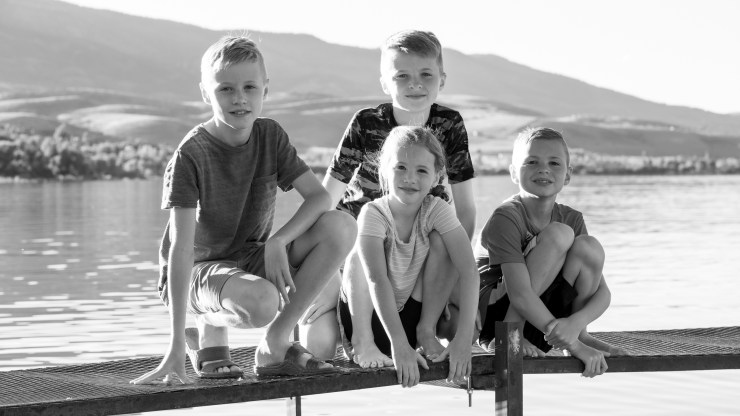I recently moved back to Cache Valley, UT, which is where I started my photography business 12 years ago. It was incredibly satisfying to receive calls for portraits from clients I hadn’t seen in nearly a decade.
Dream photoshoot
I got a call for the first photoshoot the first week I was back. Cindy called and asked me to make portraits for her during a family reunion on Wednesday night. “I want them to be all black and white,” she said, “and I’m not going to tell anyone we’re doing it: I don’t want everyone in matching khakis or something.”
Black and white? This is my kind of shoot! I did convince her that, in order to salvage her relationship with her daughters and daughters-in-law, she should give the ladies at least a few hours’ warning.

Nightmare setup
The trouble is, the sun was still pretty high when I got there and there wasn’t enough shade or there wasn’t enough sunlight to cover the whole group — at least not with a decent background. The lake (Bear Lake) is so large that there’s nothing to see across it except for a horizon line that would chop off everyone’s heads.
What to do?
Wake up and make pictures
There was a very skinny metal pier leading to a floating dock. The sun was behind it, and there was a mountain behind it as well. I started thinking that it could be a pretty good spot to put the family.
The trouble is, I’d have to either use a 1200mm lens from 200 yards away on the shore, or I’d have to be in the water to make the pictures.
There were some paddleboards for rent and some kayaks for rent, but I didn’t think it wise to go out there with a camera on one of those. So I went out on the pier to see how it looked for the group.
As it turns out, most natural lakes are the same shape under the water as they are on the land right next to the water. If there’s a cliff, then the shore probably drops steeply away, too. If there’s a long flat beach, then the same gradient probably continues into the water. That was the case here.
The water at the end of the pier ended up being just three feet deep. Totally wadeable!
I borrowed a swimsuit: Time to make pictures.

Suck it up and get it done
The only thing to worry about now was the water temperature. It was June 1 and the lake sits at 6,000 feet elevation surrounded by snow-capped peaks. I was preparing myself for a cold session, and Cindy thought I was nuts.
But I knew the pictures would be good. The water in the foreground, and the mountains behind, with the family grouped up in the middle. It was definitely the best setup available, and I was pretty sure it’d be a good group setup regardless.
There was nothing for it: I was going to get wet.
And that’s the point. If you know there’s a good picture to be made and the only thing standing between you and it is discomfort, then suck it up and be uncomfortable. You’ve heard of suffering for your art? This is it. This is what that means.
Get wet, get muddy, get in a tree, get on your belly, get sweaty. But above all, get it done.
It’s never as bad as you expected
It turns out that the water wasn’t cold. I think because it was so shallow for so far the sun had warmed that section quite a lot. I had my family reunion at the same lake last year in August, and the water was actually colder then.
I’ve had a lot of experiences when my discomfort was the price of making the shot. Rarely has the discomfort ever been as bad as I feared it would be, and the pictures have always been better than I’d imagined.
If your pride in your appearance keeps you from being uncomfortable, it’s also keeping from being the best artist you can be. So get over it, and get in the water to get the work done.
Portrait Tips come out each week, and you can see them all right here.















